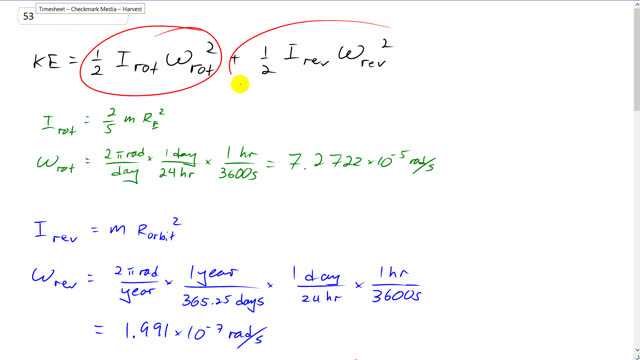
Estimate the kinetic energy of the Earth with respect to the Sun as the sum of two terms,
- that due to its daily rotation about its axis, and
- that due to its yearly revolution about the Sun. [Assume the Earth is a uniform sphere with , , and is from the Sun.]

In order to watch this solution you need to have a subscription.
This is Giancoli Answers with Mr. Dychko. The total kinetic energy of the Earth going around the Sun is due in part to the kinetic energy of the Earth's rotation every day and also the kinetic energy of its revolution around the Sun. So they have different angular speeds and different moments of inertia depending on which perspective you have. If we consider the rotational motion first, the Earth can be thought of as a sphere so its moment of inertia is two-fifths times its mass times the Earth's radius squared and its angular speed is 2π radians traveled every day and then we can convert that into radians per second by multiplying by 1 day for every 24 hours times 1 hour for every 3600 seconds and that gives 7.2722 times 10 to the minus 5 radians per second. And when we consider the revolution around the Sun, think of the Earth as a point particle because on a scale of Earth-Sun distance being so huge this Earth which we think of as being big— because we live on it— is actually really tiny speck in comparison to that Earth-Sun distance. So we'll think of it just as a single point particle in which case its moment of inertia is mass times the radius of its orbit squared. And the angular speed during its revolution is 2π radians every year times 1 year for every 365.25 days times 1 day for every 24 hours times 1 hour for every 3600 seconds and you get this many radians per second and so the total kinetic energy are these two terms after we have made substitutions for the moments of inertia. And the 2's cancel there giving us this term for the rotational kinetic energy mass times radius of the Earth squared times its rotational angular velocity squared over 5 and plugging numbers into that: 6 times 10 to the 24 kilograms times 6.4 times 10 to the 6 meters—radius of the Earth—squared times—its rotational angular velocity— 7.2722 times 10 to the minus 5 radians per second divide that by 5 after you square that angular velocity there and you get about about 2.6 times 10 to the 29 joules. And then for the kinetic energy of its revolution around the Sun, we have the same mass for the Earth times its orbit 1.5 times 10 to the 8 kilometers. Now don't let them throw you off with this kilometers here, we have to convert that into meters by multiplying by 1000 meters per kilometer and then square that result and then times 1.991 times 10 to the minus 7 radians per second square that, divide by 2 and you get this many 2.7 times 10 to the 33 joules of kinetic energy for its revolution around the Sun. So its total is these two added together and I'm also gonna show you some calculator work here. When you are dealing with scientific notation, it's often better to go second function and then this comma here which gives this capital E, capital E— that is for scientific notation. So using this as an example here this is 1.5 times 10 to the 11 I took this 10 to the 8 times a 1000 makes 10 to the 11 and then square so 1.5 times 10 to the 11 square and the reason its good to use this second function comma for the capital E is because when you put this exponent 2 the calculator already understands that this square applies to the entire thing... it implies that there are brackets around the 1.5 times 10 to the 11 square this—what I have typed into the calculator here— is what I have written here and that's good, that's what you want. If instead your technique with scientific notation is to go 1.5 times 10 to the power of 11, this would be bad because when you square it, in fact what's happening is its going 1.5 times 10 to the power of 11 squared not what you intended to say at all. So if you type that in, you get... oops yeah so it's so big the calculator can't even deal with it because you have an exponent for tan which is 11 squared and 11 squared is... (what is that) 121 so yeah it can't even fit 10 to the power of 121 in its memory. So this is bad and... (oops, what happened there, we are on 53) So use this scientific notation button in a calculator, second function E its good and it has implied brackets around the whole number and you will get answers that you want and that's the idea right? So when we add these kinetic energies together, you'll notice that the rotational kinetic energy is so small it has to be negligible. It turns this 2.6757 into 2.6760 and with two significant figures, it makes no change at all and we have a total kinetic energy 2.7 times 10 to the 33 joules just as we did for the kinetic energy due to revolution because the kinetic energy due to rotation is negligibly small in comparison to this kinetic energy for revolution.